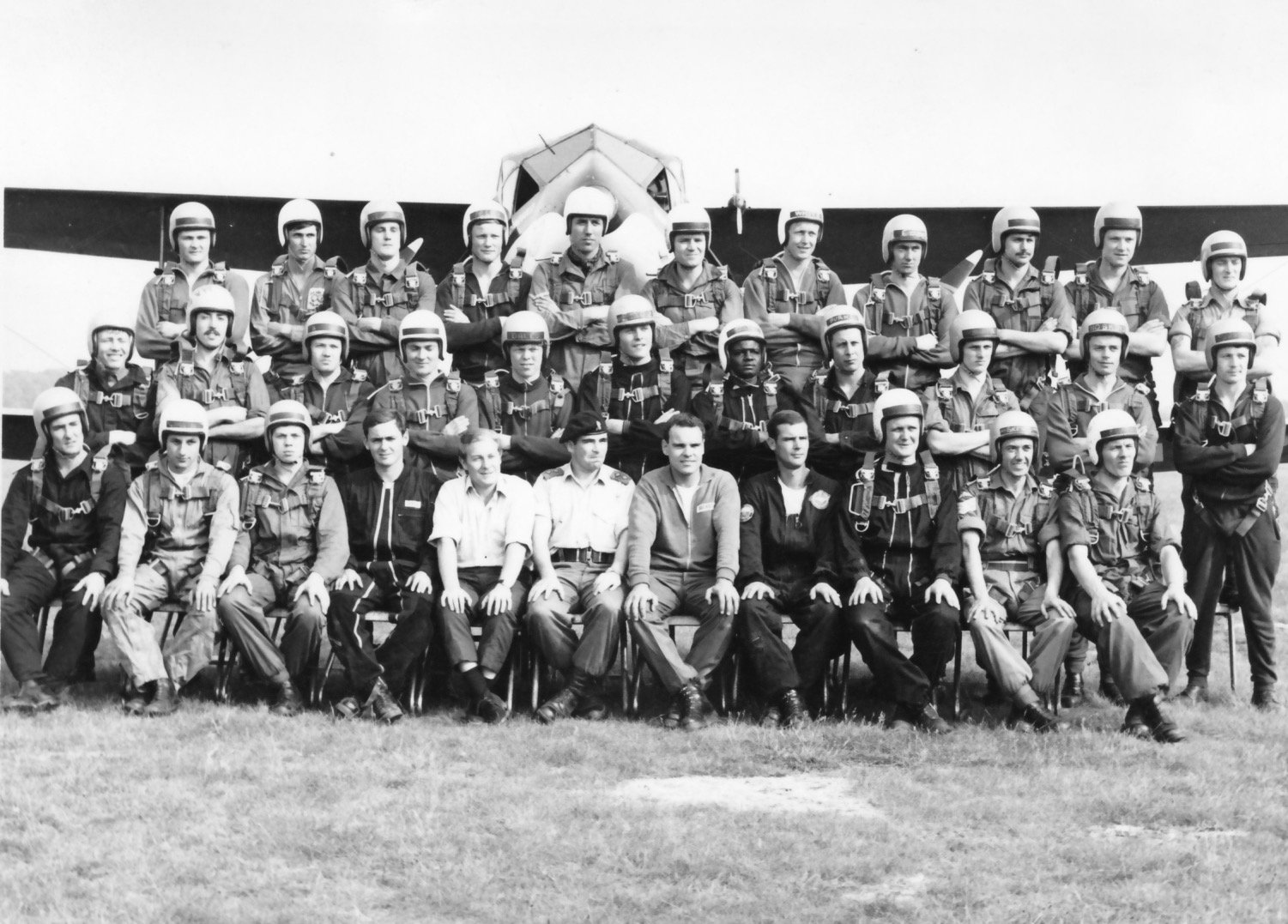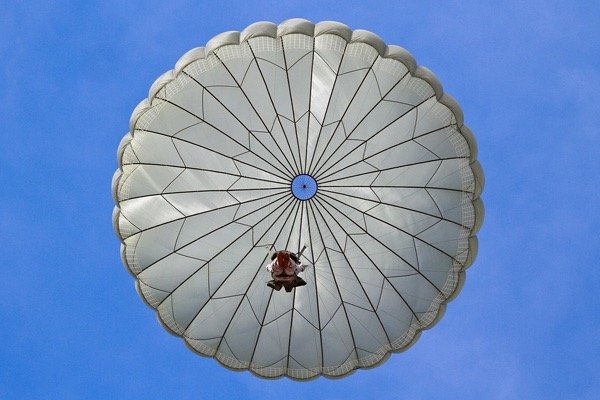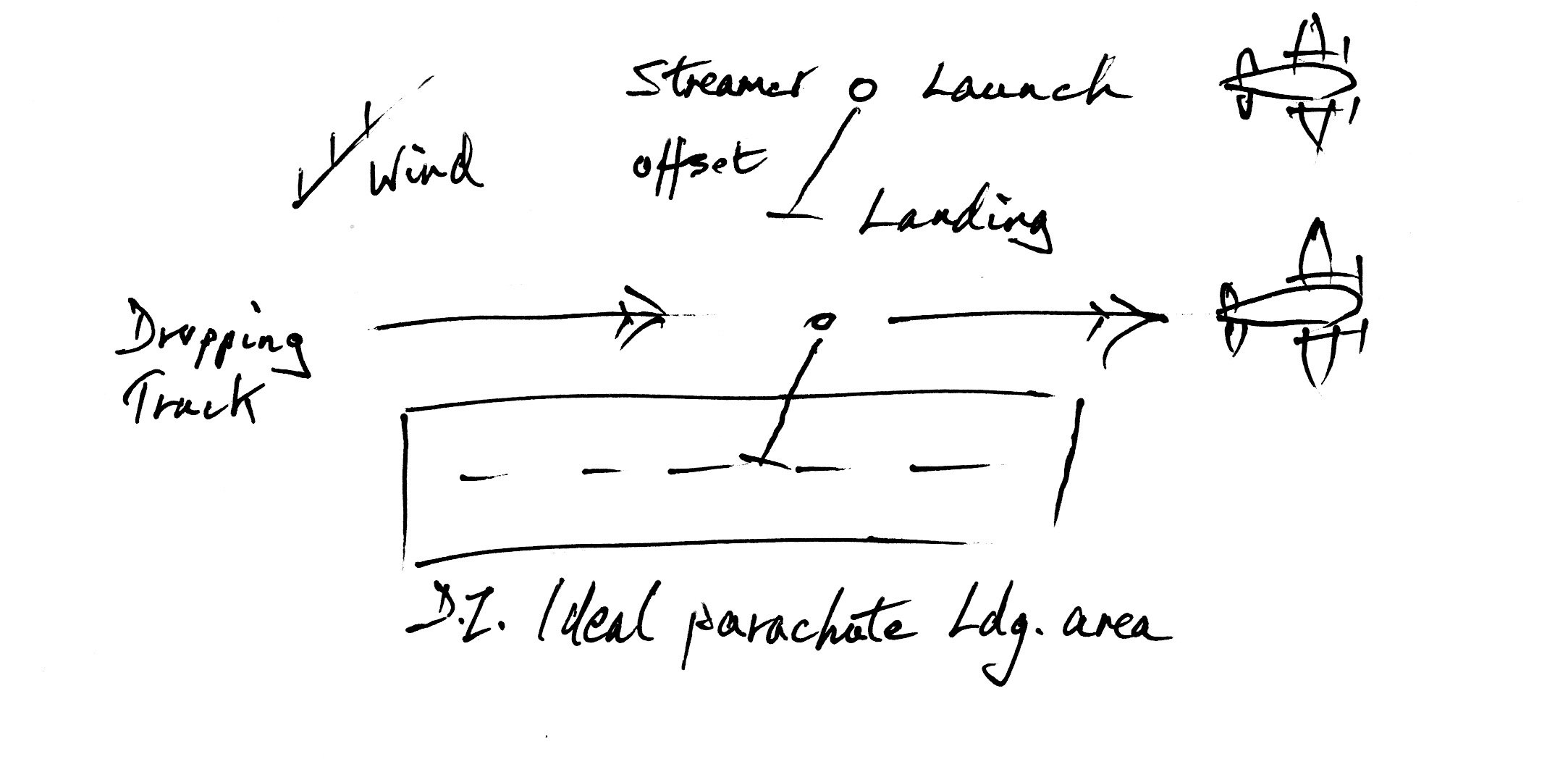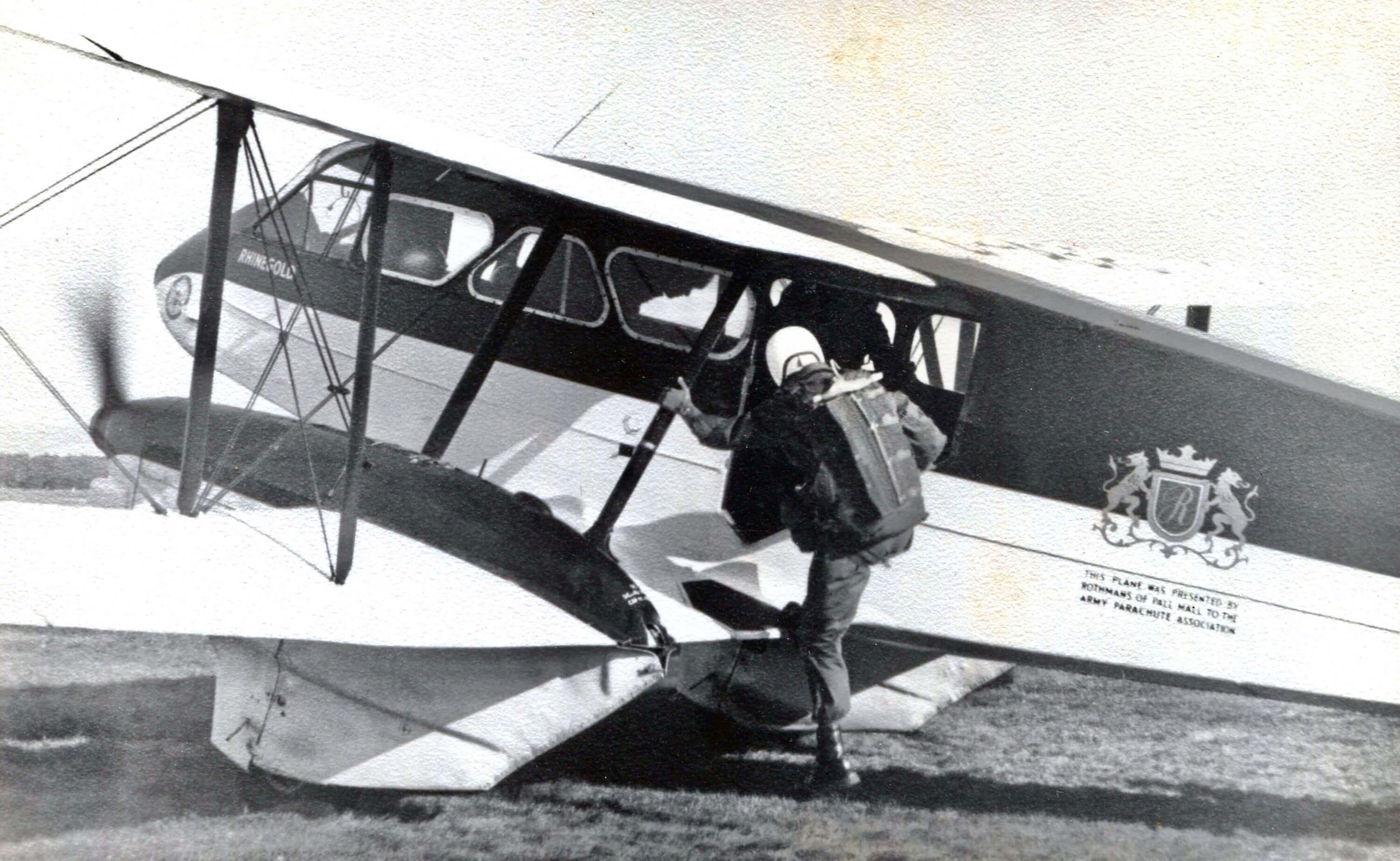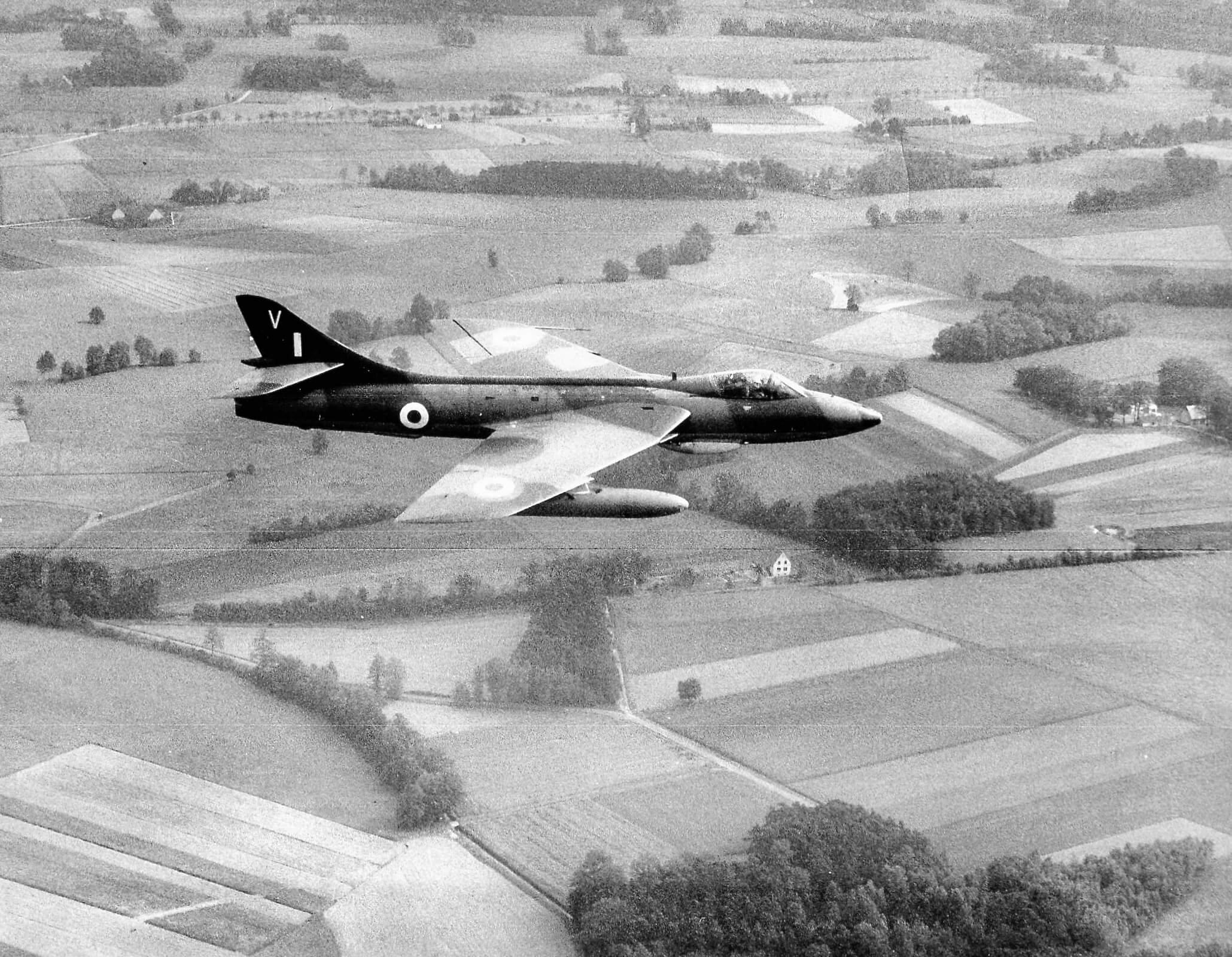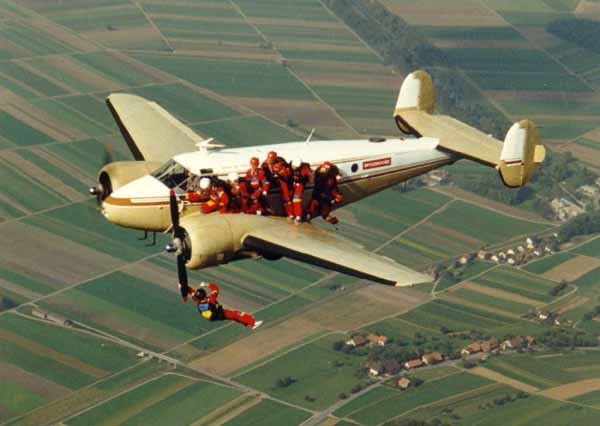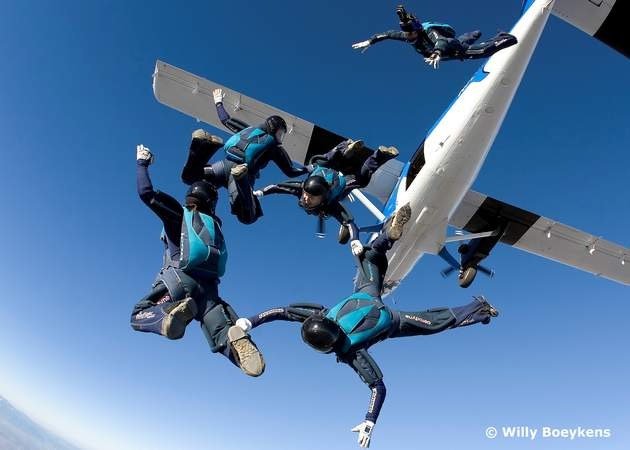Dropping parachutists - a beginner’s story
You see a lot of stuff on YouTube. Plenty of rubbish of course, but some revealing and informative clips. Anyone with a GoPro or just a smartphone can share their experiences, prejudices or influencing skills with the whole world, just like that.
Flying occurrences are popular subjects, and though many enthusiastic misinterpretations of the mundane will be put online by anoraks of little understanding, sometimes the odd and rare gem of accidental revelation may become viral.
Flying a parachute dropping aeroplane may look like another transport flight, but there can be more to it than meets the eye. And as a transport pilot by profession but an ‘If it flies I’ll give it a go’ catholic amateur by inclination I was encouraged to look back on the bundle of raw handling skills this craft might include because of the questions raised by a recent clip sent by a flying friend. It showed a Beech KingAir90 in a near vertical attitude, facing a group of free-fallers close by in their initial aerodynamically vulnerable free fall situation. How could such a thing happen? Why is this general aviation twin (mini-turboprop) joining a group of helpless airborne human bodies who have not yet acquired their own safe flying speeds?
What do I know about this subject?
It was in 1967 that Tiger Club member, accomplished aerobatic pilot and BEA professional Carl Schofield asked me if I would like to go to Germany to do some sport parachute flying in a DH Dragon Rapide for the British Army. I said yes straight away, even though I had never flown a Rapide or dropped a parachutist. I am reminded of a different invitation, ten years later. Our training manager had said “You don’t have to do it, but it’s nice to be asked.”
Here, we start with the sport parachute basics of 1967. Static line deployment and plain round canopies are common military practices, but the stable body position in free fall is the additional technique required for free falling under control: the human body as an aerodynamically controllable flying device - now popularly know as skydiving.
I duly took myself to Hanover, courtesy of a BEA Trident, and was driven to Detmold by a non-communicative German in a khaki LandRover. This reminded me of the national service driver in 1959 who had driven from Chivenor to Tiverton and back twice in order to take a seventeen year old from Tiverton to Chivenor and back once. Global warming had not been noticed then; but the army seemed to understand that the Germans weren’t the enemy any more, and that employment of locals might help their economy, and gain useful local building work (training) for the Royal Engineers. Next day my training took place. It lasted until mid morning.
On the job training
Type conversion course:
An army staff sergeant pilot, one of the two at Detmold with a UK civil licence, took me in hand for the flying of the Rapide. He asked nothing about previous experience, and was agreeably practical and informative: fellow professional would cover it. “I’ll fly us over to Bad Lippspringe, and you can fly back.”
Right engine up first
In terms of basic character the Rapide is like two Chipmunks or Stampes, side by side, but there is only one pilot’s position - no dual. Before he took off, Staff Barber explained the asymmetric throttle opening this tail dragger twin would need at the beginning of the take off roll and I watched him do it from behind his seat. We flew over the hills and trees of the Teutoberger Wald, past the huge statue of Hermann the German - saviour of his race from the Romans in distant times - and landed on the large sports field the other side of the hills. ‘A tail down wheeler is a good idea’ my pilot had said as the grass approached. He shut down and we swapped the one pilot’s seat.
There had been no discussion of checklists and procedures, and I found the framework of the traditional pre-takeoff checks for piston engines, first remembered for the Tiger Moth, quite adequate for the Rapide. We took off and returned to land on the small well-worn grass runway on the top of the hill at Detmold. Base training complete, including route experience, 15 minutes each way.
Plain round jumping
This is civilian sport parachuting, technically the Rhine Army Parachute Association. The members are not learning to be paratroops, and this job involved a course of 30 total beginners who would make 20 jumps each, advancing as far as their individual progress would allow. With the exception of Hans, a friendly German civilian employee of the RASC, all the others were army personnel from many different sources, jobs, ranks and condition. A mixed bunch of allcomers indeed, with a variety of motivations, I was to discover. Some signed up to temporarily escape a job they did not like; others were keen to learn something new: exciting, for sure, and a bit glamorous, perhaps.
A typical course
1967. An instructor’s state-of-the-art Para-Commander
1967 was early days for Skydiving as a modern sport. Had this title even been invented then? Experiments to develop canopies that could steer with ease were underway elsewhere, and our four instructors ‘jumped’ the state-of-the-art competition Para -Commander, a round parachute with many slots in it, and panels on the sides. Its tailoring complexity could cause opening complications which restricted its use to experts, and this design can still be seen on holiday beaches, towed by a boat, doing what is called parasailing.
But the availability and flying simplicity of the plain round airborne soldier’s canopy defined the training equipment of the day. This parachute descends vertically through the air, 100% drag, so its landing point is entirely dependent on its opening point and the descent wind. The parachute beginner also has no control over personal heading so landing technique is important - feet together and aligned 90⁰ to ones track over the ground is a good rule, whichever whichway that may be. [There are ways to make a round canopy track, a little, but this was not on the syllabus here.]
Plain round parachute for students
There was plenty more for this pilot to learn before lunch. I flew the empty Rapide back to the jumping site and met Mick Turner, the ‘Chef’, so named because he was the chief instructor - nothing to do with cooking. The course members had been driven over, and while they got themselves ready, with much checking of equipment, the Chef explained how the parachuting system worked, to this complete novice.
Streamer run
Before the first student jumps out the likely effect of the wind on their passive descent must be assessed by a streamer run. The Chef showed me a streamer. It’s a crepe paper banner rolled around a baton. When it’s thrown out of the doorway it unfurls and falls at 2,000 ft per minute - the same as a parachute. He will throw it at 2,000ft exactly over a chosen point below, and then I must slowly circle to the left (while continuing to climb) so we can both keep it in sight (if the pilot can see it so can he). Where it lands indicates where a parachutist would have landed if their parachute had opened over the same release point. The Chef, as jumpmaster, will then mentally transpose this wind vector offset from the area where he wants his students to safely land. He can then guide the pilot to his chosen dropping track. He drew the basics for me on the blackboard.
“Got that, Biggles?” He didn’t actually say that, and I didn’t like to ask for a repeat explanation, but so much theory, already! We haven’t got to the actual parachuting runs, but he assumed I would do what he explained. In fact I liked this practical attitude: you’re the pilot, this is what you have to do. Great.
The Chef manages from his position at the aircraft door, on the left behind the wings, where there’s a built-in left and right button on the rear bulkhead. The pilot has corresponding left and right lights on his panel. This is a case of navigation by proxy, like a bomb aimer, and you need to understand that the jumpmaster has to retain continuous visibility directly downwards in order to refine his track over the ground, using the doorway threshold as a reference. ‘Flat turns only. No banking.’ What kind of flying is this? It’s the quickest visual way to make quick track adjustments in a short distance. I was soon to reason that unless a pilot can also see vertically downwards in straight flight he can only observe his accurate position over the ground while in a turn. There are exceptions, of course, but they do not usually apply to transport aircraft.
I used the gyroscopic directional indicator (DI) as a heading reference for the wings-level course corrections, a few degrees at a time, and for the subsequent straight slow speed flight while the jumpers in their turn were altering the centre of gravity and providing extra drag and turbulence on one side. The DI is the easiest way of defining straight if all other distractions are to be ignored.
Left and right lights together means we have reached the passengers’ exit point and throttling back and keeping straight is then required until a shout of ‘OK’ indicates that two or three have departed so it’s open up, climb and make the first 180 of a mini racetrack, to arrive back at 2,500ft and the start of the next dropping run.
Minimum slipstream for beginners
A basic rule is that a beginner’s parachute should be open by 2000ft, so they jump out at 2,500ft: and the initial fall with static line opening, parachute flapping and so on will be complete before 500ft of falling. Unlike footage of military static line action these Rapide students should learn to adopt human aerodynamic stable flight from the moment their mentor shouted ‘Go’. This was a special luxury of the Rapide in that they could stand on the step provided on the bottom wing, just outside the doorway, grasp with both hands the interplane strut conveniently in front of them, and therefore face forwards into the local airspeed before the go instruction. They were then experiencing, horizontally, the basic free fall airflow, at perhaps half the free fall airspeed, before casting off.
Climbing aboard. Launch step and strut visible
Propeller wash for level flight would still generate too much local airspeed for the novice, so a power-off glide at minimum airspeed was my basic instruction. If the correct technique was employed by the student - adopting the stable free fall posture for a human - the transition from horizontal to vertical flight should take place automatically as they gained vertical airspeed and aerodynamic stability.
The basic free fall body position
Although this was static line jumping the student could learn a lot about the fundamentals of the basic stable free fall default situation from these initial 5 seconds after leaving the Rapide wing. The jumpmaster (always the Chef for us) analysed as he watched at the doorway and made brief notes on his clipboard during the downwind climbing part of the racetrack between successive dropping runs. Following each 30 student course session there was a debriefing as all sat around on the grass.
The Chef had one of those drawing class articulated wooden bendy men to indicate body and limb positions during these brief sessions of free fall practice. Each attempt was critiqued - this forearm here, this torso position so, arms too forward - back? I’ve no idea, but Strictly Come Dancing comes to mind. The similarities are remarkable - arms and legs position, arching the back, posture: strange at first - but as nature intended once you’ve got the feeling.
The objective of the initial flights was to get the students off the dope rope (static line) and into self-sufficient free fall. Once the stable flight position had been demonstrated satisfactorily before the unravelling parachute took over, the student carried out the dummy ripcord routine, while still relying on the rope. The correct flying body position is symmetrical, and the drag of four control surfaces - two arms and two legs - suitably disposed relative to the jumper’s C of G (belly button) is the basic means of control. When this human flying device brings the right arm into the body to pull the ripcord its drag is reduced, resulting in a head down/roll and yaw to the right problems. To counter this effect the left arm (in its L shape) is simultaneously rotated above the head, removing the lateral asymmetry and creating more nose (head) up moment in compensation.
It works, but the Chef needs to be confident that ripcord technique is safe before dispensing with the rope. During the 600 jumps represented by this course some members never managed to acquire the basic stable attitude and the feeling that goes with it. 20 jumps, from 2,500ft, all with static line, no progress beyond dangling under a paratroop’s parachute. On the other hand, the best student progressed to 45 seconds freefall (from 9.000ft) by the 20th exit, and also made some entertaining commentaries with a tape recorder tucked into his jacket.
What did this pilot learn?
Something of basic free fall theory, but none of the reality. I did get some informal instruction in basic landing theory, including jumping off the moving LandRover tailboard while facing to the side. This simulates the feet-90⁰-across-track touchdown technique required for a correct PLF (parachute landing fall), and this has been of use later during my paragliding career, but I was also to learn that you should not encourage a pilot to try parachuting, for three reasons.
You may have lost a useful pilot who prefers skydiving.
He may be terrified by the experience, and not come a fly for you again for fear he is invited to repeat it, or . . .
He may assume experienced parachutist notions and challenge the jumpmaster’s judgment.
After the course of 30 had all been dropped, involving four or five consecutive flights, there was time to spare while they packed their parachutes, staked out on the grass. The four instructors could now hone their relative work skills and we would climb laboriously to 12,000ft, all twelve Gipsy Queen pots firing strongly. From this altitude they had one minute’s free fall in which to practise the nascent free fall craft - join hands in flight, pass the baton, and so on. I found that if I spiralled steeply down above them I could get a good plan view of their efforts, initially, which might have helped with some feedback about positioning, but I certainly could not catch them up. They soon disappeared as tiny dots below.
Rapide management technique
A typical lift might include up to ten parachuting beginners. Naturally, the business of getting each total novice to the doorway and safely on to the wing with their cumbersome equipment took time. During the constant heading, minimum power, minimum speed glide while two or three beginners were launched, height was lost. They shuffled down the fuselage to the doorway, and from the cockpit the movement of these bodies was evident, but the changing pitching moment gave no problem - just interest, for a beginner pilot.
The Chef gave no further piloting advice as the static line phase progressed, but saving time where possible was quietly floated as the routine became familiar. Asymmetric power was not mentioned, but the quiet and slow glide along the field used all of the 500ft buffer, and more. Frequently the last of the stick stepped into space below 2,000 ft. This did not matter while a static line released the parachute, and 800ft is quite acceptable for the heavy loaded military equivalent, but the extra time taken for the Rapide to climb back to 2,500ft for the next candidates took longer than the minimum size racetrack achievable to get back to the start of the next dropping run. Why not throttle only the left engine back for minimum slipstream, and reduce the height loss? Of course it worked, and with only 200 HP per engine, critical speed did not appear to be a problem with this beautifully designed aircraft. I’ve no idea what it was, anyway - if there was one.
The Rapide has split flaps under the lower wing - on or off, like a Spitfire. These do have a small effect on stalling speed, and they increase the drag a bit for more approach flexibility. I did take to using them for the parachute dropping phase, which was appreciated, but found that reaching the left arm all the way down to the floor to press the unlocking button on the lever a bit inconvenient when otherwise busy with stick, throttles and looking outside. The answer was obvious - leave the flaps floating in the breeze when not required in the air.
The critical point for a time-efficient second half of the racetrack was the shout of ‘OK!’ from the back. The immediate and ideal requirement for me was then an efficient one eighty turn, to track parallel to the line made by our recent parachute launches, climbing on the way, and gaining some speed at the end, which could be then be lost during a climbing and turning zoom up on to the previous dropping line at 2,500ft. As soon as both throttles were open, pressing the unlock button on the flap lever was the only action required. The flaps then trailed harmlessly until required again, the floating lever in easy reach for the next two-light signal, when pull & click for the flap lever was all that was required for the slow, single engined dropping track.
Staff teamwork
The Chef’s request for efficient use of the time is easy to understand. 20 jumps for 30 jumpers in a week of European weather adds up to 600, all closely observed and critiqued. Once the routine had settled for me, an unspoken game of workload challenge developed. My intention was to get from the end of one pass to the beginning of the next in the shortest time possible, so that I could roll the wings level and adopt the asymmetric, slow speed configuration at the correct height, place and heading close to that position where the next candidate could safely jump out; the two light position in fact. During the racetrack, the sounds of grunting, boots on the floor, the physical evidence of movements in the cabin all served to indicate the jumpmaster’s eagerness to have his first customer ready on the step seconds after the wings levelled and the left engine was throttled back. I found that accurate crossing of the downwind fence, assessed during the direct view down allowed by the turn, was one answer to the desired efficiency. My view had then been the same as his. Soon there were no left/right lights, just the cut-the-power signal. From there my Newtonian gyro information was the best means of straight flight along the field.
Once students reached an independent status, the altitude menu for each lift gained variety, particularly as some students never reached this self reliant level. The others proceeded up the ladder of free fall learning, each additional 1000ft of exit height representing more time in free fall, and significantly, more personal vertical airspeed. Like all flying devices more airspeed implies greater aerodynamic forces. This can mean more control, but also greater problems if control is lost. Step by step is the approved policy for many reliable training systems, and the jumpmaster’s requirements would be called up the cabin before takeoff. These were now seldom the same for consecutive flights. “One at two five, two at three five, one at five”, might be typical as we taxied out. Here we have one pass for static liners, two for initial pull-your-own-ripcord merchants and one for a student reaching higher speeds, and perhaps learning additional effect-of-controls techniques. This relatively early stage of the human body as a comprehensive flying device might involve deliberately going out of control and proving that adopting the body’s stable configuration, come what may, will always result in stable and steady free fall - the default position: nice to know it works.
How safe is parachuting (and the aeroplane flying to go with it)?
Of course I asked myself this question because everyone knows that the aeroplane ride is safer, but is this true? Of the 600 novice jumps of this first course I expected a few landing injuries, at least, but there were none of significance. There were few non-standard descents - one because a student had incorrectly closed one of the two clips on the shoulders that connect the parachute to the jumper. This is not supposed to happen.
On parachute opening load the metalwork failed and one side of the parachute assembly streamed helplessly skywards. He correctly pulled his reserve and landed safely. What interested me, as well as the Chef, was the safety cover for this important clip which should not be able to look closed if its contents were not correct. This is an essential pre-board instructor check at this stage of training. A subsequent ground reenactment test proved that such a thing was possible - a surprise.
A second event, involving an officer student no less, was more understandable, entertaining and less technically serious. Both his parachutes, main and reserve, were deployed due ripcord finger trouble, giving a leisurely two parachute descent into the nearby trees, No damage or injuries - could happen to anyone. So we have only 2 of the 600 jumps scoring incidents - but all without significant injury. Not bad for a daredevil sport, and I cite the excellent training ethos here as the reason.
As to the aeroplane flying one has to be sensible. This beginner’s story so far describes a novice pilot walking into an environment of slow speed, asymmetric power, aft centres of gravity, extraneous drag and airflow disturbance etc.. All of this applies, which is why satisfactory parachute piloting requires an element of piloting expertise and understanding. The YouTube BeechKingAir90 full spin event indicates an extreme case of loss of control. This is a bad situation for anyone, and the pilot’s report blames the presence of too many enthusiasts crowding the rear door area and the rails outside, thus making this Beech uncontrollable - in the upwards direction. This may be true for this aircraft. A parachuting pilot should understand that a parachutist’s enthusiasm is directed solely on free fall action and the canopy ride. The aeroplane trip is of little interest, and advice/requests about behaviour prior to their departure may fall on deaf ears. Here might be a good place to say that large and slow is better than small when it comes to aircraft characteristics.
My first display drop in Germany featured smoke flares, strapped to the jumpers’ ankles. The Rapide is a wood and fabric aircraft, apart from minimum metalwork which triangulates the engines, mainwheels and top wing support. I was present at the briefing which stressed ‘Do not activate your flares until you have left the aircraft, it’s made of wood (oil and petrol)’. Nodding in agreement gave an impression of compliance, but the real thing was quite different. As the exit point was approached there were explosive sounds, visible red fire and the cabin filled with smoke. Then the team jumped from wing and doorway as one, more or less, to demonstrate the relative work and link ups currently fashionable.
From the flight deck (single pilot’s seat), and now quite alone in the Rapide at say 8,000 ft, I wondered if the on-board pyrotechnics might signal my demise. I did not have a parachute (that was to come later), and hoped the clearing smoke would not reveal real flames. After landing I had a look for fire damage. Yes, there was some: blackened marks on the fabric outside the doorway, and bits and pieces of pyrotechnic confetti about the floor inside. The bastards had pulled their strings while inside. One lives and learns - to learn and live in the future.
Spinning while parachuting
I haven’t done this, but got a tiny feel of it one day. The Rapide has a sophisticated, elegant and pointy wing planform for its day, quite unlike the rectangular or parallelogram shapes of previous DH biplane designs of the 1930s. Something more elliptical with a higher aspect ratio would certainly be more efficient for cruising, and so it was. But pointy wings tend to be wing droppers at the stall, and I was aware of the landing cautions for the Rapide.
Roger Wilkins came along with his son one day. Another volunteer Rapide pilot, Roger was a photographic reconnaissance Hunter pilot at RAF Gütersloh, but this visit was a school holiday look-see ride for the son, and a chance to see some parachuting action up close. The pair of them hung about near the door and the jumpmaster’s storage box cum seat. After the first pass at 2,500 ft and the OK shout I opened up, released the flaps to their float position and rolled into my left turn, as usual. Barely had the turn started when I felt the jolt of the tip stall and the rolling moment. An instinctive backing off of elevator and a touch of right rudder cancelled this behaviour, and the turn could continue, but I felt guilty of a public lapse of judgment. There are no excuses among professionals. After we landed nothing was said, but what had this real pilot thought about this airline pilot’s handling skills and awareness.
“Sorry about the stall”, I said. “Probably our extra weight at the back”, he said. He was right, of course, and I hadn’t thought of changed pitch response while pulling into the turn. There was nothing more to say, but we did discuss the air to air photo sortie he was planning. The time, place, height and heading was arranged for the rendezvous. “What’s your slowest Hunter speed” I asked. 130 kts was the number. “That’s faster than the Rapide can go so I’ll put you on the outside of a gentle turn.” This all worked, though he did not fly especially close. I’m not surprised.
Forty years later I noticed that a Hunter in the museum at Hendon has his name on the side. Is it the same man? I’ve yet to find out.
Roger Wilkins as photographer
Rapide going fast
Potential performance problem for the modestly powered Rapide
We all know that if a single engined aircraft suffers an engine failure, the rest of the flight is generally downwards, and of limited range. A twin engined machine is faced with double the chance of an engine failure, though the optimistic assumption is that the flight can continue on the remaining example. But sport parachuting often involves heavy takeoffs, and the Rapide with ten strapping jumpers and their 1960s equipment was no exception: it descended on one engine. Without the jumpers plus parachutes, reserves, boots and helmets aboard, the Rapide flew beautifully on one 200hp engine, with just pilot and jumpmaster to carry. By the time I made my second visit to the Rhineland a few months later, the heavy possibility had been partially addressed, and the pilot now had his own parachute; but this would only apply in the dire fire case. I do know of a UK Rapide ferry flight engine fire, speedy landing in a soggy meadow by the River Cherwell - with noseover. The pilot ran down the ceiling and out of the doorway as the upside down collection of wood and doped fabric began to burn out completely.
This negative climb after takeoff situation with a full load presented choices, depending on the engine failure height. If it’s not possible to return and land at the takeoff site a low parachute descent might be a better option, for those with parachutes, than a single-engine overweight crash landing in the rough ground around the field. This used to be a tank range, churned up sand with fir trees. The instructors told me they would launch the static line students down to 600ft. They themselves would jump as low as 200ft, back to the wind, reserve already pulled and held closed until out of the aircraft when it could thrown to the wind and blossom in an instant. A minor version of this did occur on a Sunday morning with club jumpers, not students. I could almost maintain 2,000ft by nursing the failing engine, and offered the enthusiasts the option of staying aboard for an uneventful landing, or jumping out as we passed overhead. There was no discussion: they jumped out. Of course, once some of the parachutists have left, the Rapide will fly nicely on its remaining engine, and I will leave the subject of the single engine ferry to the reader’s imagination.
Suitable aircraft for the job
There are few aircraft designed exclusively for launching recreational parachutes. Informed readers may leap out of their chairs to disagree, but the cost of such a specialised project would make little commercial sense. Yet there are ubiquitous transport aircraft that have proved themselves very capable of meeting this requirement, especially now that monster link up boogies are becoming popular. And with an enormous rise in skydiving popularity since the 1967 events already described, multi-purpose but relatively economical and simple aircraft are proving popular for skydiving as well as cheaper short range freighting.
Monster 400-way link up. Photo by Bruno Brokken
What do you need?
This is easy:- plenty of space inside, easy exit unobstructed by wings or tail surfaces, slow speed with forgiving low speed handling, good climb rate, good short field performance, ability to accommodate airborne C of G changes, and so on. The good climb rate combined with the ability to carry many jumpers is much appreciated for communal skydiving, and operating cost now becomes a major consideration. For short range flying, especially where takeoff and landing occur at the same place, cruise performance is not important. To meet this list of features bigger is more beautiful, and simplicity of operation a great help. Low wing loading and powerful engine give you the climb and the slow speed you may prefer, and one should not forget the considerable Reynolds number advantage of large for a low speed aircraft. A retractable undercarriage is not required.
What happened to the smallish KingAir90?
The pilot reported that more jumpers than was agreed beforehand made their way out of the door to hang on to the outside rail. The cameraman appears to be holding on to the after end of the rail with his left hand. Loss of tailplane effect is reported for this type if the aerodynamic disturbance of bodies in front of it becomes too effective. A few seconds before the left wing stalls the nose can be seen to rise steadily by a few degrees from its steady position; this is unlikely to have been deliberate pilot action, and the effect of these two factors does appear to have caused this event, though I have no knowledge of the stall behaviour of this aircraft, the actual C of G and trim positions, and other ramifications of asymmetric power. The pilot reported that recovery was straightforward, and that a safe return to the field was normal, in so many words. The video looked more exciting than that, but all’s well that ends well, some say!
The 1937 Beech18 is not a large aircraft, but has a great reputation. This is a fun shot, but the jumpers are not all hanging on near the tail. The left engine is feathered - in case you ask.
A 4-way group about to get it together as they accelerate downwards, pursued by their video man - part of the contest team. FAI website picture by Willy Boeykens
GoPro footage
The following excerpts illustrate the surprise results of the special demands of the free fall parachuting sport on their jump aircraft and pilot, when special enthusiasm for Formation Parachuting, a FAI-sanctioned competitive sport, has the potential to cause unintended crossovers into Aerobatics - another FAI sport. Jump aircraft tend to be modified for but not designed exclusively for skydiving (or aerobatics). Aft C of G, low speed, tailplane blanking appear to be the reasons for the total losses of control. Types of aircraft featured here are KingAir91, C47 military version of the DC3 Dakota, and Cessna208 Caravan in Poland. In each case a variety of individuals’ GoPro files of the same event are played in succession. GoPro footage is by far the best way to analyse and indeed officially judge attempts at formation skydiving, and a great amount of detail is displayed.
Also, in each of these cases excessive aft C of G positions combined with reducing airspeed seem to have caused a total loss of nose down pitch control, with elevator fully forward. What happens thereafter varies, but the Cessna’s brief autorotation appears to stop after 90 degrees of roll to the left. What happens next is not clear, and there is a clear jumper’s video of this aircraft in a level inverted attitude. Thereafter we have some imagery indicating sustained negative flight - straps hanging towards the ceiling, jumpers struggling on the wall or ceiling as they attempt to reach the doorway. Did this pilot respond to the stall warning with full down elevator, or was it applied already. Such possibilities encouraged the next paragraph
Thoughts on this subject immediately suggested another Connections with Everything blog topic. This would explain something about competition aerobatic technique, in particular the crossover negative spin and its entry - as almost demonstrated by the Cessna Caravan in Poland, perhaps.
Read more about the King Air 90 Skydiving Aircraft

